Q&A – Ask Neil: November 16, 2023
(Please read these instructions carefully.)
Before you post your question, please look at recent issues to see if someone else has already asked it. You might find your answer there.
How to submit your question…
(Note: You may need to allow a pop-up window to come up in order to get the link for sending your photo(s). If you have already submitted your question and didn’t see the pop-up window, please click here.)
• Click the link provided below to post your question. After you submit your question, a new window will pop up giving you the address to which you can e-mail a SHARP, HIGH-RESOLUTION PHOTO to accompany your question. Please DO NOT SEND THUMBNAIL PHOTOS in case I need to zoom in to see things.
• Click here to post your question.
• Please ONLY POST YOUR QUESTION ONE TIME. We can only accept a set number of questions each week, and when we get duplicates it costs other people their chances.
• One question per reader, please.
• Please use this only for posting questions – not for standard emails.
• Watch for your answer in the following week’s e-gardens.
• I choose those of greatest general interest. For example, plant IDs seldom make the cut.
• I must have your first name or initials.
• I must have your city or county. (Texas is a very large state.)
QUESTION 1
IS IT OK TO OVERSEED WINTER RYE FOR BARE SPOTS IN ST. AUGUSTINE?
Question: My St. Augustine took a beating from last year’s early freeze and excessive shade. The trees have been trimmed, but bald spots remain. Is it OK to seed with winter rye to hold the soil on a sloped yard? Will the St. Augustine eventually grow over it? Fred B., Mesquite.
Answer: You can certainly seed the ryegrass, but it’s so late in the fall that I worry it may not germinate very well until February. As for whether the St. Augustine will grow to cover the bare areas, not unless you plant new sod or plugs in late April or May. I’ll warn you that the trees may very well grow back to fill in the bare spaces. That often happens. I can’t tell without seeing a photo.
QUESTION 2
HOW DO I CARE FOR MY NEW BUR OAK SEEDLING?
Question: I received this bur oak sapling at a local Texas Arbor Day event. I’ve read your advice about wrapping the trunk and staking nursery trees, but does that apply to one this size? How should I care for this one? How much water? Daniel H., Brady.

Answer: Neither wrapping the trunk nor staking would apply to your bur oak seedling. However, you get my award for being the most attentive subscriber to e-gardens! You’ve read all the rules. Bur oaks are more forgiving than Shumard red oaks and certainly the smaller ones like this one. No staking. No wrapping. Just water it if you don’t get rain for 5-7 days. Well done!
QUESTION 3
WHAT IS HAPPENING TO MY BLUE POINT JUNIPER?
Question: What is infecting my Blue Point juniper? The tips of just the needles have been dying off. No large sections of the branches have died yet. Otherwise, it’s healthy. Chris M., Flower Mound.

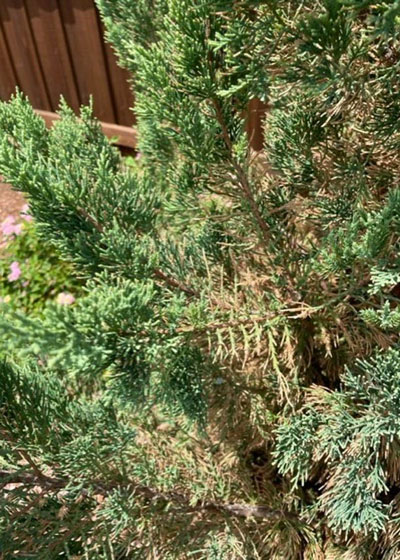
Answer: This looks very much like spider mites. Thump one of those branches over a sheet of white paper. If you see nearly microscopic specks starting to move around freely on the paper, those are the spider mites. You will need to spray with a general-purpose insecticide that is labeled for control of mites. Apply it with enough pressure that it penetrates all the foliage. It’s worth noting that the particular species of mites that attack junipers, arborvitae and other conifers is quite active in cooler temperatures.
QUESTION 4
WHAT IS WRONG WITH MY CRAPE MYRTLE?
Question: What is wrong with my crape myrtle? I took these photos two months ago and now the leaves are brown. Paul S., Frisco.
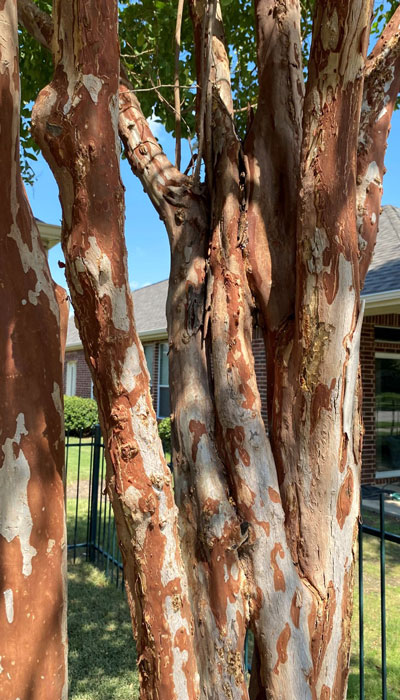
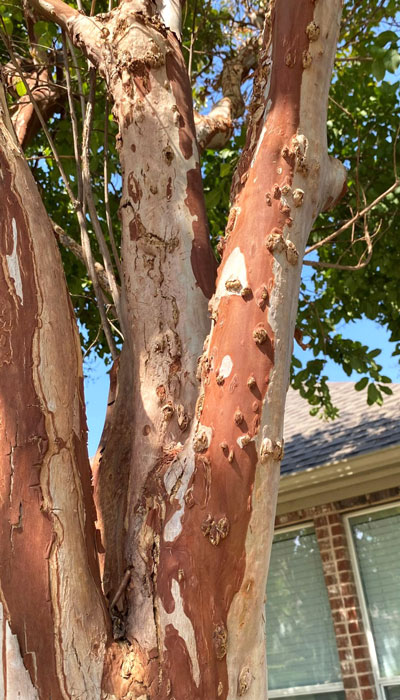

Answer: Hmm. I work with crape myrtles almost every day as a founding member of The Crape Myrtle Trails of McKinney. These appear to me to be one of the Don Egolf varieties from the United States National Arboretum such as Natchez or one of the others with Indian tribal names. They are hybrids of Lagerstroemia fauriei, a Japanese species that Dr. Egolf selected for (a) its resistance to powdery mildew and (b) its beautiful cinnamon-colored, exfoliating bark. These look completely normal to me. The knobby growths occur on many crape myrtle plants. It’s just the way their trunks develop. The browning leaves are showing up because of autumn. I’ve looked closely and I can’t see anything of concern.
QUESTION 5
WILL OUR YEW COME BACK?
Question: This yew has been hardy for many years. In late spring 2022 it was overgrown, so we trimmed it way back. The summer of 2022 burned it. We considered cutting it back to 12 inches from the ground, but then we saw green shoots coming up. Will it come back, or should go ahead and trim it back? Also, we’re hoping the two new hollies on either side are established. They were planted 12 months ago. Fred L., Coppell.
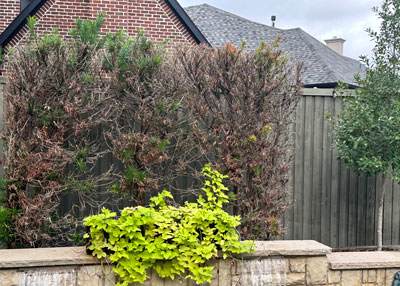
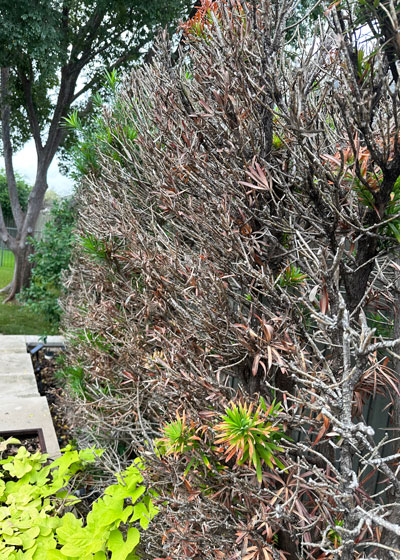
Answer: I need to be honest in several respects. The yew plants (there appear to be several) amaze me. Most people in North Texas lost them in the cold of February 2021. The fact that yours survived until you pruned them in “late spring 2022” is very surprising. That may also mean that they had put on lots of new growth that spring, only to have it removed. That was probably really tough on them. I suspect that had more to do with the dieback than the hot summer. I will answer as if this were my landscape: I would replace them. I’ve tried Japanese yews in Collin County (adjacent to you) on three occasions over the years (because I’m stubborn), and I’m now willing to add them to my “never-again, Neil” list. As for your holly, it looks like it’s doing really well. You might look at all the other types of hollies and their different growth forms and textures to see if you could find a replacement for the yews that you like out of that big category.
QUESTION 6
SHOULD I TRIM THE SMALLER STALK ON MY CHINESE PISTACHIO?
Question: I have a small Chinese pistachio tree. It has two stalks near the bottom. I’m concerned about the form it will take in 5-10 years. Should I trim the smaller stalk? David G., Kaufman.
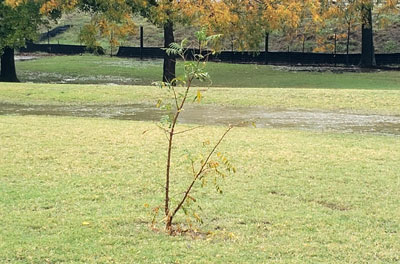
Answer: I’m already concerned. I would trim if off this winter. Make the cut about 1/4-inch from the main trunk. That would leave a small amount of branch collar over which new bark could form as it heals. Young Chinese pistachios are gangly trees for their first few years, but it will take nice shape as it matures. But that low branch needs to go now.
